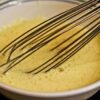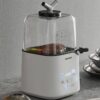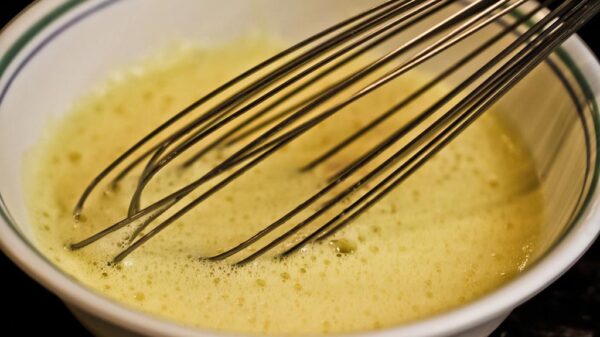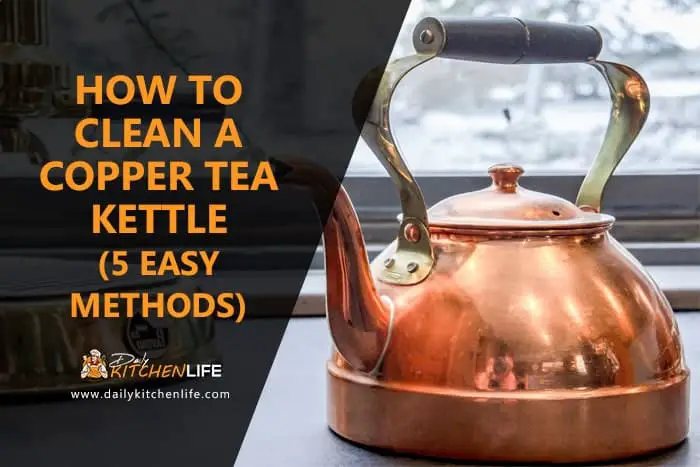 Whether you’re thinking about having a cup of coffee or tea to get started in the morning, an electric kettle can be a real helping hand to you. It makes water boiled faster than ever. But, how do you clean the inside of an electric kettle when you notice limescale and water deposits? Well, your answer is here, in this article. Boiling water with an oven or a pot above the stove is a bit old-fashioned. Those days are gone. People give value to time now and as an electric kettle does its job pretty faster, it’s one of the first priorities of those who love to have a cup of coffee or tea in the morning. Now, when you use your electric kettle from time to time, you may find lime scales or water deposits, or brown residue inside your kettle. This happens when you don’t discard the water properly. Water contains iron oxide, limescale, calcium naturally. The mineral item leeches out when you give heat to water and boil it. In this case, you need to clean your kettle in a proper manner. This article is about the cleaning procedure of the inside of your electric kettle to keep your kitchen appliance secure for a long time. Let’s discuss how you can do it step by step.
Whether you’re thinking about having a cup of coffee or tea to get started in the morning, an electric kettle can be a real helping hand to you. It makes water boiled faster than ever. But, how do you clean the inside of an electric kettle when you notice limescale and water deposits? Well, your answer is here, in this article. Boiling water with an oven or a pot above the stove is a bit old-fashioned. Those days are gone. People give value to time now and as an electric kettle does its job pretty faster, it’s one of the first priorities of those who love to have a cup of coffee or tea in the morning. Now, when you use your electric kettle from time to time, you may find lime scales or water deposits, or brown residue inside your kettle. This happens when you don’t discard the water properly. Water contains iron oxide, limescale, calcium naturally. The mineral item leeches out when you give heat to water and boil it. In this case, you need to clean your kettle in a proper manner. This article is about the cleaning procedure of the inside of your electric kettle to keep your kitchen appliance secure for a long time. Let’s discuss how you can do it step by step.
Popular methods
- Using vinegar
- Using citric acid powder
Unpopular working methods
- Using lemon
- Using coke
- Using CLR
- Using baking soda
How to clean kettle using vinegar
This is considered to be the most effective and common way to clean an electric kettle. To clean your electric kettle using vinegar you just need
- Vinegar
- Distilled water
- Scrubber
- Step 1: Take 1 cup of vinegar and pour it into your kettle.
- Step 2: Take 1 cup of distilled water and pour this too! You have to make sure that your kettle is at least 50% filled with water and vinegar equally.
- Step 3: Boil the mixture of vinegar and water and turn your kettle off.
- Step 4: Keep the mixture in your kettle for 30 minutes and discard it after that.
- Step 5: Do some scrubbing if required. This process will descale everything that’s inside your kettle. It’ll make the inside of your kettle clean and shiny easily.
(Note: When you’re cleaning with vinegar you need to boil mineral water a few times after cleaning and discard. You have to make sure the taste of vinegar is gone.)
Cleaning kettle Using citric acid powder
Here’s how do you clean the inside of an electric kettle using mineral water and citric acid powder. To do this you need:
- Mineral water
- 1 or 2 table spoon of citric acid powder
- Scrubber
- Step 1: Pour water into the kettle and fill ¾ of it.
- Step 2: Turn the kettle on and let the water boil.
- Step 3: When the water is boiled turn it off and unplug it.
- Step 4: Now open up the kettle and add 1 or 2 tablespoons of citric acid powder to the boiled water. Make sure they’re mixed properly.
- Step 5: Keep the mixture for 30-40 minutes and let the water cool down.
- Step 6: Discard the mixture and clean the inside using the scrubber if you think it’s required.
(Note: Don’t add too much citric acid powder.)
How to clean an electric kettle with lemon
In this process of cleaning, what you need is
- ½ cup of Lemon juice
- 2 cup of distilled water
- Step 1: Pour the lemon juice solution and the water into the kettle.
- Step 2: Boil it and turn off the kettle and unplug it.
- Step 3: Keep the solution for 30 minutes.
- Step 4: Discard the solution and apply water. Rinse with water.
How to clean kettle with baking soda
To remove the scaling with baking soda and water solution, you need
- 1 spoon of baking soda
- Mineral cold water
- Scrubber
- Step 1: Make a solution of baking soda and water. Mix it properly.
- Step 2: Pour it into your kettle and boil it.
- Step 3: Turn off the kettle when boiled and keep it for 20-25 minutes.
- Step 4: Dump the solution and clean the kettle with cold water. Use a scrubber if required.
How to clean kettle with coke
Cleaning kettle with coke is the easiest thing to do. In this process, you need
- Enough coke to fulfill your kettle
- Water
- Scrubber
- Step 1: Pour coke into your kettle. Make sure your kettle is almost full.
- Step 2: Boil coke and turn your kettle off when finished.
- Step 3: Keep it for 30 minutes to cool down.
- Step 4: Dump the coke and apply water. Use a scrubber if needed. (Note: Make sure the manufacturer of your kettle didn’t prohibit cleaning it with coke. It affects some material.)
Check out our latest article about how to clean a copper tea kettle and how to clean a coffee maker with bleach
How to clean kettle with CLR (Calcium Lime Rust)
Cleaning with CLR is a smart choice. In this process, you’re not boiling the solution. To perform the cleaning, you need
- 1 cup of CLR
- 1 cup of cold water
- Step 1: Unplug your kettle from the power source.
- Step 2: Pour 1 cup of CLR and 1 Cup of water into the kettle.
- Step 3: Agitate the mixture in the kettle and keep it for 2-3 minutes.
- Step 4: Dump the water CLR solution and clean the kettle with water. (Note: Do not use in kettles which contains exposed heating element)
Additional Tips for Using an Electric Kettle
- Make a routine and clean your kettle from time to time. You can choose 2 days a week.
- When you clean your kettle, make sure you’re cleaning the outside too! Use dish soap to clean the outside and don’t forget to wipe it with a piece of cloth.
- Don’t leave leftover water inside your kettle. It causes limescale the most.
- To eliminate mineral deposits, try using distilled water.
- Try cleaning the outside of your kettle at least once in 10 days.
- Don’t ever drown your kettle in water.
- Use proper power supply and always try to maintain recommendations from the manufacturer.
Final Thoughts
So, we tried to describe how do you clean the inside of an electric kettle. We’ve tried to show you all the available methods. As it’s a tool that runs with electricity, always try to maintain the rules and regulations. Following the steps shown above will surely clean all the limescale easily. Don’t pour water while your kettle is plugged in. If you think that this article is helpful for you then please share the article with your friends and family. Stay safe and healthy.
You can check out our latest articles:















